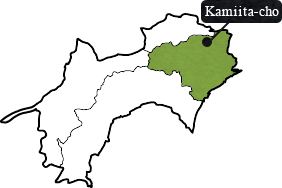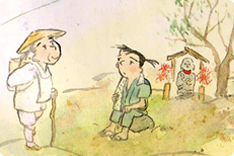Wasanbon toh is presently produced only in the Tokushima and Kagawa prefectures. It contains "Chikutoh", which is cultivated in the northern and southern parts of the Asan mountains bordering these prefectures.
 That which is produced in the southern part of the mountains on the Tokushima side is called "Awa wasanbon toh." To be more precise, Awa wasanbon toh is produced in the town of Kamiita-cho in Itano county of Tokushima prefecture.
That which is produced in the southern part of the mountains on the Tokushima side is called "Awa wasanbon toh." To be more precise, Awa wasanbon toh is produced in the town of Kamiita-cho in Itano county of Tokushima prefecture.
Although sugar cane is generally considered to grow only in tropical areas, it also grows well in Shikoku. The sugar cane used for Wasanbon toh called "Chikutoh" is different in appearance and taste from other sugar cane cultivated in the southern countries such as Taiwan or Cuba.
 The production center of Awa wasanbon toh is located in a basin that extends from the Asan mountains to the south. It is a sunny, well drained location. Because of the good drainage, it was difficult to grow rice during the Edo period, when there was no irrigation system.
The production center of Awa wasanbon toh is located in a basin that extends from the Asan mountains to the south. It is a sunny, well drained location. Because of the good drainage, it was difficult to grow rice during the Edo period, when there was no irrigation system.
It is said that when an ascetic monk passed through Tokushima, he told the local people that sugar cane was produced in Kyushu in soil similar to theirs. A young man named Maruyama Tokuya, who had heard about this, went alone to Hyuga(present Miyazaki prefecture) and returned having mastered the way to produce sugar cane. This is said to be the origin of sugar cane cultivation in Tokushima.
The history of cultivating sugar cane in Japan started during the Edo period when Shugun Tokugawa Yoshimune encouraged its production all over Japan. It seems that since that period "Chikutoh", the ingredient in wasanbon toh, has remained the best suited kind of sugar cane for the soil there.
Approximately 230 years has past since cultivating sugar cane first began in Tokushima. It seems that sugar cane was being cultivated in several places in western Japan before the war. Due to its disadvantage in terms of productivity thin "Chikutoh" is seldom cultivated except in the production of wasanbon toh.
Blessed with lucky geographical condition of sunny, well drained basin on the south side of the mountain range, farmers have increased gross area for cultivating sugar cane. Harvesting is intentionally delayed until about December in order to increase the sugar content of the sugar cane. Long ago, farmers harvested the sugar cane after the regular harvest season, squeezed it, and boiled down the juice to make sugar. At that time only "Shiroshita toh(coarse sugar)" was produced, which required only simple production facilities.
Later, the technique of refining coarse sugar to make white sugar was invented. Thus began the production of Wasanbon toh. The method of refining sugar by using water is quite rare in the world. It is not known how this method was discovered.
One story is that while carrying "Shiroshita toh" in the barrel, a person dropped it into a river by mistake. When the person picked it up, the top part had turned white from being washed by water. This is, however, only a story. The technique of squeezing out the syrup using the principle of leverage is obviously one application of equipment used for extracting sake lees called "Oshifune" at sake shops in those days.
Having acquired this technique, farmers who had the facilities for refining sugar started to buy sugar cane other farmers and began to produce and sell wasanbon toh under commercial names. This is the origin of the sugar manufacturing industry.
At one point Awa wasanbon toh's production spread widely and became a special product of Tokushima prefecture that rivaled the other special product, "Ai(indigo)". After the war, however, production decreased rapidly as cheap refined sugar began to be imported from places such as Taiwan. Although wasanbon toh is no longer used as ordinary sugar, its unique flavor and taste make it indispensable in Japanese sweets. It is still produced as special domestic sugar for Japanese sweets. As quality is more and more sought after, only the best centers for sugar cane cultivation continue to produce.
The production centers of Awa wasanbon toh are at present the towns of Kamiita-cho and Donari-cho in Itano county in Tokushima prefecture. With people's increased concern for quality foods, wasanbon toh has recently gained fame. It is sold in some department stores as a luxury food. On the other hand the aging farming population and the decreasing number of farming households is likely to lead to the further reduction in sugar cane production.

